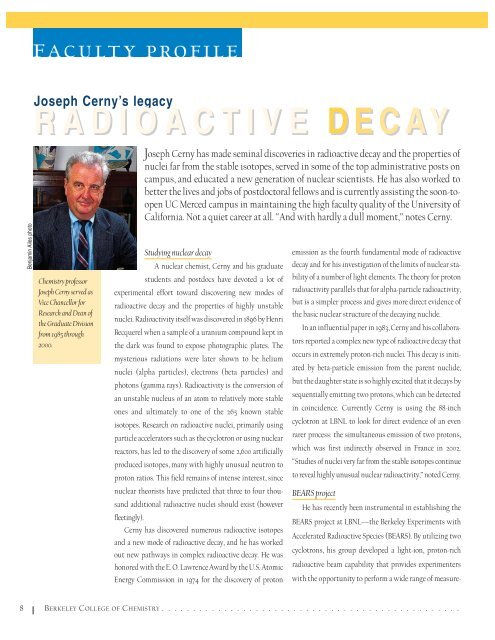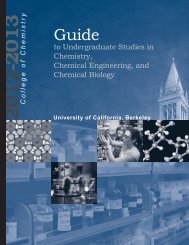Newsjournal body.qxp - College of Chemistry - University of ...
Newsjournal body.qxp - College of Chemistry - University of ...
Newsjournal body.qxp - College of Chemistry - University of ...
You also want an ePaper? Increase the reach of your titles
YUMPU automatically turns print PDFs into web optimized ePapers that Google loves.
Benjamin Ailes photo<br />
Faculty pr<strong>of</strong>ile<br />
Joseph Cerny’s legacy<br />
RADIOACTIVE D E C AY<br />
<strong>Chemistry</strong> pr<strong>of</strong>essor<br />
Joseph Cerny served as<br />
Vice Chancellor for<br />
Research and Dean <strong>of</strong><br />
the Graduate Division<br />
from 1985 through<br />
2000.<br />
Joseph Cerny has made seminal discoveries in radioactive decay and the properties <strong>of</strong><br />
nuclei far from the stable isotopes, served in some <strong>of</strong> the top administrative posts on<br />
campus, and educated a new generation <strong>of</strong> nuclear scientists. He has also worked to<br />
better the lives and jobs <strong>of</strong> postdoctoral fellows and is currently assisting the soon-toopen<br />
UC Merced campus in maintaining the high faculty quality <strong>of</strong> the <strong>University</strong> <strong>of</strong><br />
California. Not a quiet career at all. “And with hardly a dull moment,” notes Cerny.<br />
Studying nuclear decay<br />
A nuclear chemist, Cerny and his graduate<br />
students and postdocs have devoted a lot <strong>of</strong><br />
experimental effort toward discovering new modes <strong>of</strong><br />
radioactive decay and the properties <strong>of</strong> highly unstable<br />
nuclei. Radioactivity itself was discovered in 1896 by Henri<br />
Becquerel when a sample <strong>of</strong> a uranium compound kept in<br />
the dark was found to expose photographic plates. The<br />
mysterious radiations were later shown to be helium<br />
nuclei (alpha particles), electrons (beta particles) and<br />
photons (gamma rays). Radioactivity is the conversion <strong>of</strong><br />
an unstable nucleus <strong>of</strong> an atom to relatively more stable<br />
ones and ultimately to one <strong>of</strong> the 265 known stable<br />
isotopes. Research on radioactive nuclei, primarily using<br />
particle accelerators such as the cyclotron or using nuclear<br />
reactors, has led to the discovery <strong>of</strong> some 2,600 artificially<br />
produced isotopes, many with highly unusual neutron to<br />
proton ratios. This field remains <strong>of</strong> intense interest, since<br />
nuclear theorists have predicted that three to four thousand<br />
additional radioactive nuclei should exist (however<br />
fleetingly).<br />
Cerny has discovered numerous radioactive isotopes<br />
and a new mode <strong>of</strong> radioactive decay, and he has worked<br />
out new pathways in complex radioactive decay. He was<br />
honored with the E. O. Lawrence Award by the U.S. Atomic<br />
Energy Commission in 1974 for the discovery <strong>of</strong> proton<br />
emission as the fourth fundamental mode <strong>of</strong> radioactive<br />
decay and for his investigation <strong>of</strong> the limits <strong>of</strong> nuclear stability<br />
<strong>of</strong> a number <strong>of</strong> light elements. The theory for proton<br />
radioactivity parallels that for alpha-particle radioactivity,<br />
but is a simpler process and gives more direct evidence <strong>of</strong><br />
the basic nuclear structure <strong>of</strong> the decaying nuclide.<br />
In an influential paper in 1983, Cerny and his collaborators<br />
reported a complex new type <strong>of</strong> radioactive decay that<br />
occurs in extremely proton-rich nuclei. This decay is initiated<br />
by beta-particle emission from the parent nuclide,<br />
but the daughter state is so highly excited that it decays by<br />
sequentially emitting two protons, which can be detected<br />
in coincidence. Currently Cerny is using the 88-inch<br />
cyclotron at LBNL to look for direct evidence <strong>of</strong> an even<br />
rarer process: the simultaneous emission <strong>of</strong> two protons,<br />
which was first indirectly observed in France in 2002.<br />
“Studies <strong>of</strong> nuclei very far from the stable isotopes continue<br />
to reveal highly unusual nuclear radioactivity,” noted Cerny.<br />
BEARS project<br />
He has recently been instrumental in establishing the<br />
BEARS project at LBNL—the Berkeley Experiments with<br />
Accelerated Radioactive Species (BEARS). By utilizing two<br />
cyclotrons, his group developed a light-ion, proton-rich<br />
radioactive beam capability that provides experimenters<br />
with the opportunity to perform a wide range <strong>of</strong> measure-<br />
8 BERKELEY COLLEGE OF CHEMISTRY . . . . . . . . . . . . . . . . . . . . . . . . . . . . . . . . . . . . . . . . . . . . . . . .




